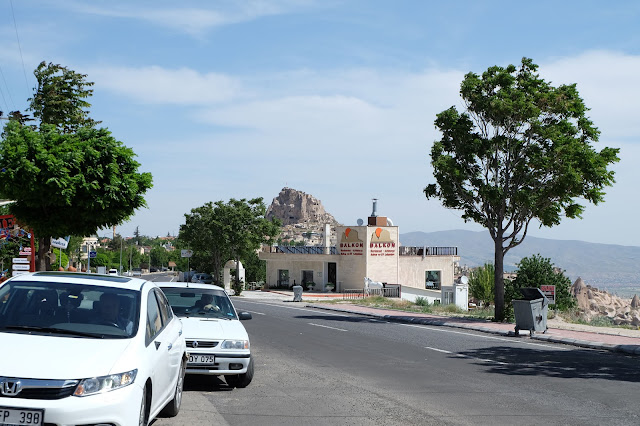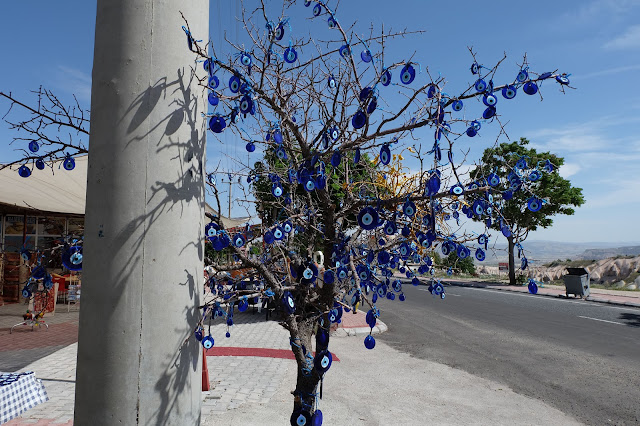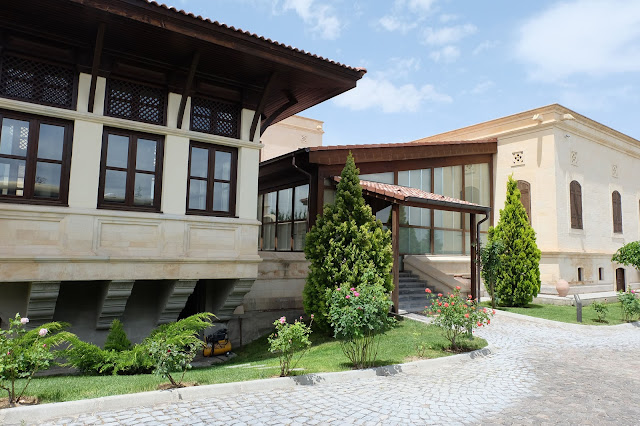[Travelogue] Turkey Trip, Day 5 | Cappadocia part 2 :)
By Lasmarya Hadi Purwanto - August 07, 2016
I'm sorry that I didn't come back to continue the story as soon as I could, again and again the internet connection in my house was off again, due to unclear reason. *sigh *sigh Glad that it's back after almost a week off. Really hope that it won't happen anymore in the future. *pray *pray
Well well, here's another part of the fifth day trip in Turkey. Coming back from the hot air balloon, we grabbed some breakfast in the hotel restaurant and had some time to walk around the hotel building. As Cappadocia is located nowhere near any water bodies, there's no such view like the gorgeous Aegean Sea as seen from the hotel, but the hotel building itself spares us some beautiful sights to see :)
After breakfast, we were taken to Gerome Onyx Jewellery and being introduced to a gemstone called Zultanite.
Relatively new to the jewelry world, Zultanite is one gemstone whose amazing natural color changing abilities makes it well suited to savvy jewelry connoisseurs. As you watch its colors change from kiwi to champagne to raspberry, you too will be entranced by Zultanite's 100% natural beauty. The pinnacle of exclusivity, beauty, rarity and desirability, Zultanite is a rising star in fine jewelry due to its sparklingly brilliant tranquil colors. Like Tanzanite, Zultanite is so rare that it comes to you from only one source in the world, a remote mountain area in Anatolia, Turkey. Named by Murat Akgun in honor of the 36 sultans who ruled the Ottoman Empire in Anatolia in the late 13th century, Zultanite is a true Turkish delight. - gemstone.org
No camera is allowed inside, so I don't have any footage of it. But all I could say, that it's a very beautiful piece of gemstone, and with a very refined cutting, it would be one-of-a-kind jewellery piece that could complete your fashion.
(Photo taken from google.com)
Since I was not buying anything, (I was dead broke, remember? Haha), (ps: Being inside, I had to kept restraining myself and kept warning myself about my pocket condition which was left to almost nothing T.T) I walked out and headed to the bus. Found this "Blue Eye" tree in front of a souvenir shop next to the bus stop. Couldn't help myself taking pictures of it. I wish I had enough money to take the tree home and give out the blue eyes to all the people around me to wish them safety and luck.
Next stop, the Carpet Factory. We were shown of how to weave the carpet stitch per stitch, where all the threads come from, the cooked cocoon and how to differentiate the best quality carpet (a carefully hand-woven one) from the others of lower quality ones. One of the reasons why carpets are expensive is because they usually take months-years to finish, and each knot is made by made ONE by ONE, imagine how many thousands knot should be made to finish one carpet with such complicated patterns. No wonder one carpet could cost so much.
Had our lunch at Uranos Sarikaya, a famous cave restaurant in Cappadocia. Though we didn't get the chance to stay in a cave hotel, eating in this kind of restaurant kinda compensate for that. The service was good and we were accompanied by instrumental music played by a musician in the middle of the hall.
The view on the way.
Cappadocia is a city full of rock formations created by ancient volcano eruptions which eroded into hundreds of pillars and minaret-like forms. People of the earlier era built out houses, churches and even underground cities under the rocks.


Visited one of the underground cities found in Cappadocia. There are still a lot others which are not open for public. These underground cities were built by farmers in ancient times to hide from enemies when war broke out.
(The tour guide asked,"When the ancient people lived down here, there's no toilet, no pipelines, so what would they do if they need to poo?" pointing at the big pot in the corner. "They stored it there," he continued.)
More info for Cappadocia's underground cities, click here.
(credit to cappadociaturkey.net)
After the eruption of Mount Erciyes about 2,000 years ago, ash and lava formed soft rocks in the Cappadocia Region, covering a region of about 20,000 km2. The softer rock was eroded by wind and water, leaving the hard cap rock on top of pillars, forming the present-day fairy chimneys. People of Göreme, at the heart of the Cappadocia Region, realized that these soft rocks could be easily carved out to form houses, churches, monasteries. - wikipedia
The Goreme Open-Air Museum resembles a vast monastic complex composed of scores of refectory monasteries placed side-by-side, each with its own fantastic church.It contains the finest of the rock-cut churches, with beautiful frescoes (wall paintings) whose colors still retain all their original freshness. It also presents unique examples of rock hewn architecture and fresco technique. The Goreme Open Air Museum has been a member of UNESCO World Heritage List since 1984, and was one of the first two UNESCO sites in Turkey. - goreme.com
And back to the hotel with another almost-sunset view.
The hotel building is so majestic and artistic! And look at the window! How cute they are!
Couldn't restrain myself from taking pictures of the hotel! XD
Will be heading to Ankara on the next entry!
Be back soon! :)
Be back soon! :)

































































0 comments
New comments are not allowed.